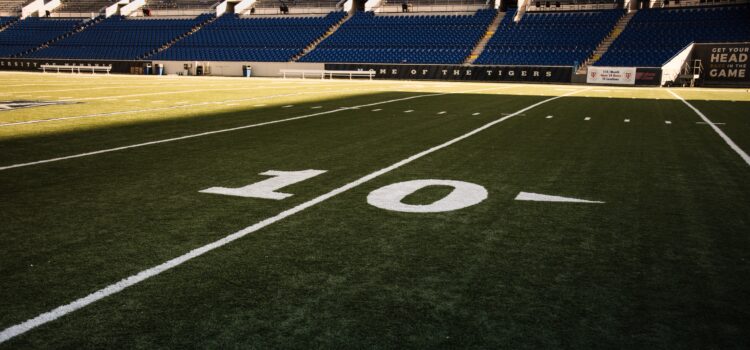

This article is an excerpt from the Shortform book guide to "The Blind Side" by Michael Lewis. Shortform has the world's best summaries and analyses of books you should be reading.
Like this article? Sign up for a free trial here .
Who is Coach Bill Walsh? How did he change the way professional football is played?
According to The Blind Side, Coach Bill Walsh was a coach with the Cincinnati Bengals who introduced the “West Coast Offense.” Coach Bill Walsh helped develop offensive systems to keep quarterbacks away from strong left tackles like Lawrence Taylor.
Read more about Coach Bill Walsh, the NFL, and how he helped reshape football.
Who Was Coach Bill Walsh?
But something else had happened in the ’70s to change how the passing game was played—Coach Bill Walsh introduced the “West Coast Offense” and changed the NFL forever.
A Man on a Mission
Coach Bill Walsh was the assistant coach of the Cincinnati Bengals in 1975. High in a press box during that year’s playoffs, he called plays down to the head coach, Paul Brown, during a game against the Oakland Raiders. In the last few minutes of the game, the Bengals were down by 3 points. Their only hope was to pass the ball downfield, something Walsh had been dreading. The Bengals quarterback pulled back and looked for the open man, which gave the Raiders’ pass rusher enough time to slip his defender and tackle the quarterback. Game over. Season over.
In that moment, Walsh knew he needed to design offensive plays that accounted for the blind side rushers. Where Bill Parcells saw defense as the key to winning, Walsh saw a strategic offense as a dire necessity to the success of any team. He didn’t see the quarterback as the star playmaker. Rather, the quarterback was the King in chess, whose movements were only possible because of the strategic moves made with the other pieces.
In 1968, when Walsh joined the Bengals, his quarterback, Virgil Carter, was anything but a king. He was incapable of throwing the ball longer than 20 yards at a time, but those short passes were always dead on. Coupled with an inadequate offensive line, the running game was also useless. Walsh had to find a way to get the most out of a terrible situation.
Coach Bill Walsh developed a specific passing system to account for Carter’s ineptitudes, one in which he made short, quick passes to locations already determined beforehand. The receivers had specific locations where they were meant to be, timed perfectly with Carter’s steps. After the snap, Carter took either 3 or 5 steps backward, and depending on how many steps he took, a certain number of receivers reacted in kind.
There was no longer the need to scan the field and wait for a receiver to get open. Carter had already decided which side of the field the play would happen on before entering the line of scrimmage. Based on the way the defense lined up, he cut his choices from three to two, and a quick look when play went into motion told him which of the two was the most advantageous. He didn’t have to pay attention to anything else. He took his steps and threw to a spot on the field. The receiver would be there to meet the ball.
The timing for this type of pass game had to be meticulous and automatic. It was tedious work to practice and took most of the spontaneity out of the game. But the advantages were great. First, the short passes were just on the other side of the line of scrimmage, so yards were open to the receiver after the catch, rather than the receiver trying to gain yards before the pass. Second, the quick and short passes lowered the chances for interceptions and incompletions. Third, the less time the quarterback held the ball, the less time the pass rusher had to sack him.
In 1971, under this new system, Carter went from completing less than half his pass attempts to completing 62% of them, leading the league. His yardage also went up by almost two full yards. The next year, a new quarterback took over for the Bengals, and the same thing happened. After Walsh was passed up for the head coaching job when Brown retired, he went to San Diego and helped their quarterback lead the league in passing percentage. This trend followed him through two years as head coach at Stanford, and finally, in 1979, Walsh took over as head coach of the San Francisco 49ers, who had a 2-14 record the year before and one of the worst quarterbacks in the league.
The Intersection of Walsh and Lawrence Taylor
Coach Bill Walsh in the NFL had lowered the risk of passing and threat to the quarterback with his system, but that all changed once Taylor stepped on the field. His freakish body type of brawn and speed had never been seen before, and despite the quicker release of the quarterback, Taylor was fast enough to make it basically obsolete.
Walsh realized he had to find a way to stop Taylor from throwing the rhythm of the West Coast Offense out of whack with his speed. He needed someone who could stop him. Before Taylor, a reasonably sized linebacker was enough to create space for the quarterback. Now, he needed someone much bigger and stronger to stop the blind side pass rush. Enter John Ayers, a ranch cowboy from Texas.
Ayers was 6’5” and 270 pounds and fast on his feet. In the off-season, he wrangled bulls and pulled tractor trailers attached to his body around miles of open field. He was used to rooting his feet and dealing with giant creatures, which meant he was perfect to go up against Taylor. In January 1982, the Giants and 49ers competed in the playoffs. Walsh planned to run 17 of the first 22 plays as passes. He told the broadcasters as much, which meant Parcells knew it, too. And everyone knew that Joe Montana would be squarely in the crosshairs of Lawrence Taylor.
The first play of the game, Montana stepped back to throw and Taylor charged on his blind side. Then, suddenly, he ran into the brick wall of Ayers. The pass was completed, and Montana was able to complete 15 of the first 22 passes, which led to two touchdowns and a score of 24-10 at halftime. Taylor became so frustrated, he essentially gave up during the rest of the game. The 49ers went on to win the game 38-24, the most points the Giants had given that season. They followed that success all the way to the Super Bowl Championship.
The two coaches came away from that game with new but different perspectives. Parcells realized that moving Ayers over to left tackle to deal with Taylor created holes for other linemen to rush through, which he started to exploit. Walsh also saw these holes and realized he couldn’t borrow from the offensive line. He needed a dedicated player at left tackle whose sole mission was to stop the blind side rusher.
Coach Bill Walsh of the NFL not only made the passing game the new successful way to gain yardage and win games, thereby increasing the value of the quarterback position. He added value to the need for another equally important position, the left tackle. And although it would take more years and more convincing for other teams to see the light, the light eventually did shine down on this new way of play.

———End of Preview———
Like what you just read? Read the rest of the world's best book summary and analysis of Michael Lewis's "The Blind Side" at Shortform .
Here's what you'll find in our full The Blind Side summary :
- How Michael Oher went from the projects in Memphis to the NFL
- Why the combination of size and speed became essential for football stars
- How Oher was taken in by the wealthy Tuohy family






